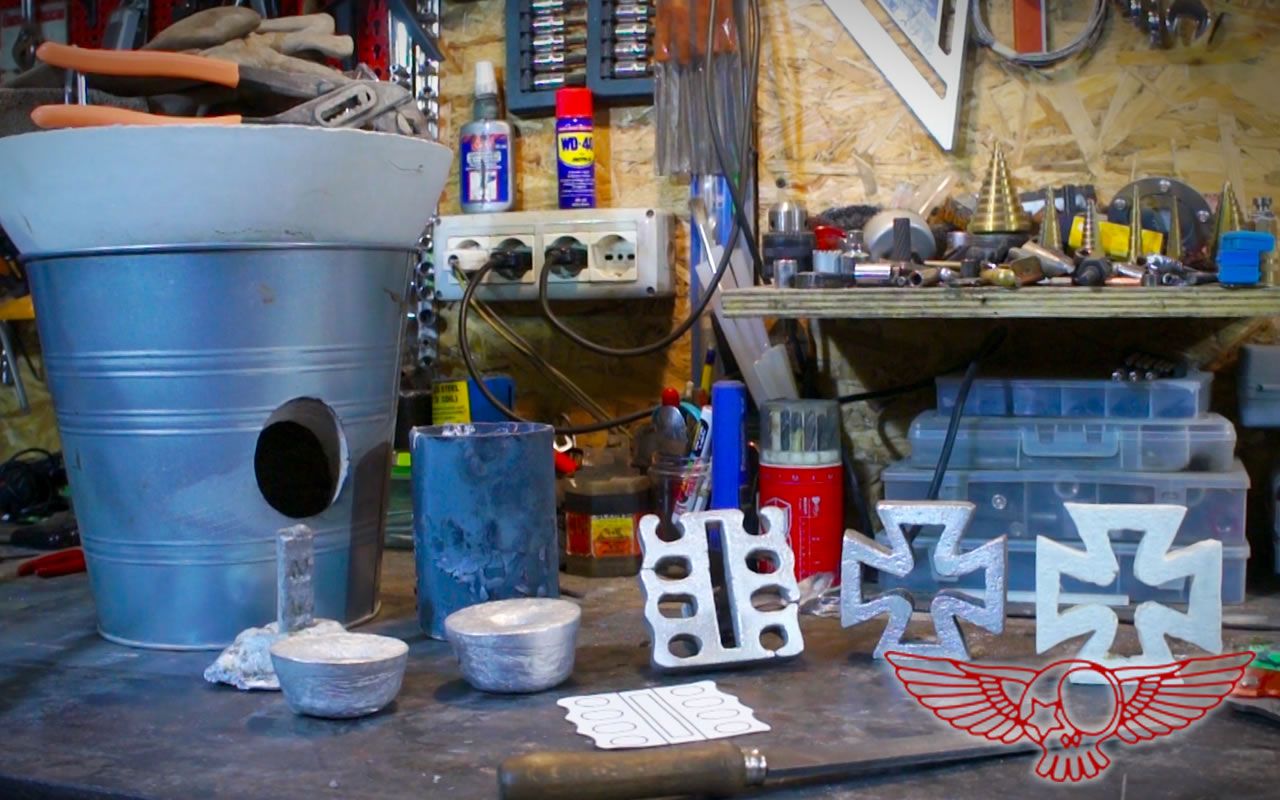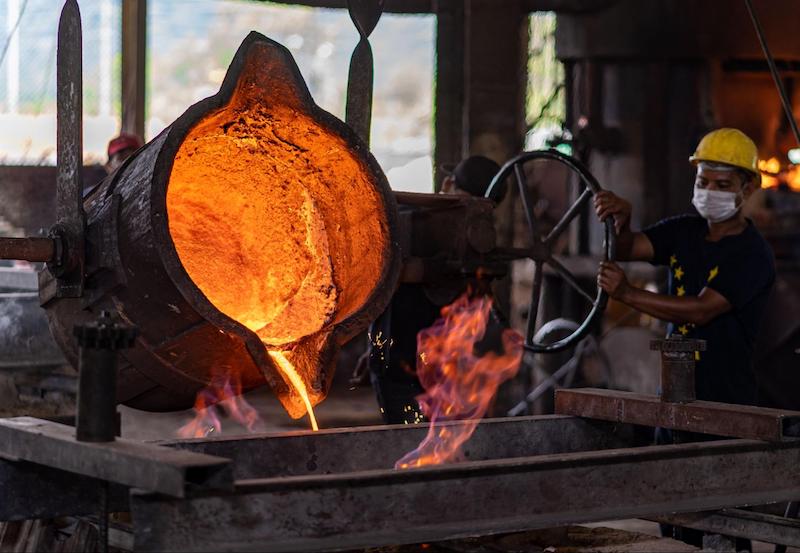Aluminum Foundry and renewable energy: Wind-driven sustainability
Finding the Significance of Aluminum Foundry in Sustainable Design Practices
Aluminum foundries are significantly recognized for their necessary duty in lasting design. By recycling aluminum and utilizing ingenious innovations, they add to source preservation and minimized exhausts. This technique cultivates a round economic situation, boosting item quality while minimizing environmental effect. Nonetheless, the journey in the direction of sustainability in steel spreading is stuffed with obstacles and possibilities that necessitate more expedition. What lies ahead for light weight aluminum foundries in the pursuit for a greener future?
The Function of Aluminum Foundries in Resource Conservation
Aluminum foundries play a necessary duty in source conservation by efficiently reusing light weight aluminum materials. These centers are crucial in changing scrap aluminum right into high-quality items, consequently decreasing the need for brand-new aluminum removal. The process involves thawing down used light weight aluminum products, which requires markedly much less energy than producing light weight aluminum from raw bauxite ore. By utilizing existing products, foundries assist decrease greenhouse gas exhausts connected with mining and refining procedures.
Aluminum foundries add to waste decrease by diverting scrap from garbage dumps, promoting a much more lasting method to source administration. They often team up with industries to gather post-consumer and post-industrial light weight aluminum waste, improving the total recycling infrastructure. This method not only saves natural deposits however additionally supports the economic climate by developing jobs and promoting innovation in sustainable design techniques. Through these efforts, light weight aluminum foundries exhibit a commitment to ecological stewardship and source efficiency in manufacturing.
Reusing and Repurposing: A Round Economy Method
The principle of a round economy is progressively obtaining traction in different industries, including aluminum foundries. This method highlights the relevance of reusing and repurposing materials to minimize waste and enhance resource use. In aluminum foundries, recycling includes recovering scrap light weight aluminum from manufacturing procedures and end-of-life items, substantially lowering the need for virgin materials. This not just preserves natural deposits but also lowers energy consumption associated with aluminum production.
Repurposing, on the other hand, involves transforming discarded light weight aluminum items right into brand-new, practical products, consequently expanding their life process. By taking on these techniques, light weight aluminum foundries add to a lasting manufacturing environment that focuses on environmental obligation. The integration of recycling and repurposing within the light weight aluminum market lines up with wider sustainability goals, driving development and enhancing the financial stability of round economic climate principles (Aluminum Foundry). Inevitably, this strategy promotes durability within the industry while lowering its environmental footprint
Cutting-edge Technologies Changing Aluminum Casting
Cutting-edge modern technologies are reshaping the aluminum spreading industry by presenting sophisticated molding techniques that boost precision and efficiency. In addition, the advancement of environmentally friendly alloys is advertising sustainability while preserving performance requirements. Automation in casting processes better simplifies production, reducing waste and power consumption.
Advanced Molding Techniques

Eco-Friendly Alloy Development
As the need for lasting methods in producing expands, the development of environmentally friendly aluminum alloys has actually arised as a vital focus within the light weight aluminum spreading market. These innovative alloys intend to minimize environmental impact while keeping premium performance qualities. Researchers are checking out the incorporation of recycled materials and safe elements, which not just reduce the carbon footprint but additionally improve source performance. Advanced techniques, such as using bio-based ingredients, are being examined to boost alloy residential or commercial properties without endangering sustainability. Furthermore, collaborations in between academia and sector are promoting the creation of alloys customized for specific applications, making certain that green alternatives fulfill the extensive needs of contemporary design. This commitment to sustainability placements the aluminum spreading industry as a leader in accountable manufacturing methods.
Automation in Casting Procedures
While the aluminum casting sector embraces sustainability, automation in casting procedures is simultaneously reinventing manufacturing effectiveness and top quality. Advanced technologies such as robot arms, computer system numerical control (CNC) makers, and expert system are enhancing procedures, minimizing labor prices, and minimizing human error. These technologies enable accurate control over spreading criteria, ensuring consistent product high quality and lowering material waste. Additionally, automated systems can keep track of real-time information, enabling prompt adjustments to enhance performance. Because of this, makers can boost their sustainability initiatives by improving resource utilization and lowering energy usage. The combination of automation not only satisfies the growing demand for top notch light weight aluminum parts yet additionally straightens with eco-friendly practices, marking a substantial development in the aluminum foundry sector.
Reducing Carbon Footprints Through Lasting Practices
A substantial decrease in carbon footprints can be accomplished through the implementation of lasting techniques in light weight aluminum foundries. By embracing energy-efficient technologies, foundries can lessen power usage, content thus lowering greenhouse gas exhausts. In addition, the combination of recycled aluminum greatly lowers the demand for raw product extraction, which is resource-intensive and adds to ecological deterioration.
Implementing innovative melting strategies, such as induction melting, can likewise enhance efficiency and minimize exhausts. Moreover, enhancing the spreading process through automation and monitoring can lessen waste and energy use.

The Impact of Aluminum Foundries on Different Industries
Aluminum foundries play a substantial role across different markets, giving lightweight and resilient products that improve product efficiency and sustainability. In the auto field, aluminum spreadings contribute to fuel efficiency by minimizing automobile weight, inevitably bring about reduced emissions. The aerospace industry gain from aluminum's strength-to-weight proportion, enabling the manufacturing of more reliable aircraft designs. In construction, aluminum components provide corrosion resistance and longevity, making buildings more sustainable in time. Furthermore, the electronics industry utilizes light weight aluminum for its superb thermal conductivity, which is important for heat dissipation in tools. Furthermore, aluminum foundries support the production of customer products, providing cosmetically pleasing and useful items. As markets increasingly focus on sustainability, the duty of aluminum foundries becomes extra important, making sure that materials not just satisfy performance criteria however also straighten with environmental goals. Subsequently, the effect of aluminum foundries prolongs across numerous industries, driving development and promoting lasting methods.
Difficulties and Opportunities in Lasting Metal Casting
As sectors endeavor for sustainability, the obstacles and opportunities in lasting metal casting come to be significantly noticeable. One considerable obstacle is the environmental influence of standard spreading processes, which usually include high power consumption and discharges. In addition, the need for knowledgeable labor in sustainable methods postures difficulties for lots of foundries. Chances are plentiful with innovations in technology, such as the combination of energy-efficient strategies and the usage of recycled materials. Emphasizing the circular economic climate, foundries can lower waste and lower costs while improving item top quality. Cooperation amongst stakeholders, including providers and clients, can cause cutting-edge approaches that promote sustainability. In addition, governing pressures encourage foundries to adopt greener practices, transforming difficulties right into methods for growth. By addressing these challenges, the steel spreading sector can place itself as a leader in lasting design, eventually adding to a much more ecologically accountable future.
Future Patterns in Aluminum Foundry Practices for Sustainability

Ingenious Recycling Techniques
While the demand for lasting techniques continues to increase, cutting-edge recycling strategies are emerging as essential remedies within the light weight aluminum foundry industry. Advanced techniques such as closed-loop recycling are obtaining traction, allowing for the repurposing of scrap aluminum directly back right into the manufacturing procedure. This strategy not only reduces waste however additionally lowers the carbon footprint connected with aluminum production. Furthermore, the advancement of innovative sorting modern technologies enhances the performance of reusing procedures, ensuring top quality feedstock for foundries. Methods like hydrometallurgical recycling additional enhance resource recovery, enabling the extraction of important materials from complex aluminum alloys. As these innovations evolve, they considerably contribute to a more lasting aluminum foundry sector, lining up with international environmental goals.
Energy-Efficient Spreading Approaches
Ingenious recycling methods lead the way for advancements in energy-efficient spreading approaches within the aluminum foundry sector. These approaches focus on decreasing energy intake and check this lessening waste throughout the casting process. Strategies such as die casting and investment spreading are being fine-tuned to enhance thermal performance and reduce cycle times. Additionally, the assimilation of wise innovations and automation allows for real-time surveillance and optimization of energy usage. Researchers are additionally checking out alternative products and additives that can better enhance energy performance (Aluminum Foundry). The shift in the direction of sustainable techniques is not site simply governing; it shows an expanding market need for greener items. As energy-efficient spreading techniques evolve, they assure to noticeably lower the carbon impact of aluminum production while maintaining quality and efficiency standards
Regularly Asked Questions
What Are the Ecological Advantages of Aluminum Foundries Compared to Various Other Steels?
Aluminum foundries provide substantial environmental advantages, consisting of lower power intake, decreased greenhouse gas exhausts, and recyclability. Contrasted to other steels, light weight aluminum's light-weight nature boosts fuel effectiveness in transport, further adding to sustainability in numerous industries.
Exactly How Do Aluminum Foundries Add To Neighborhood Economic Climates and Task Production?
Aluminum foundries play a vital duty in local economic climates by producing work opportunities and supporting supplementary markets. Their procedures boost financial growth, enhance workforce skills, and foster neighborhood growth via investment in local infrastructure and services.
What Precaution Are Applied in Aluminum Foundry Procedures?
Precaution in aluminum foundry operations include personal protective equipment, ventilation systems to reduce exposure to fumes, normal tools upkeep, safety and security training for staff members, and rigorous adherence to sector laws to decrease threats and warranty employee security.
Exactly How Can Consumers Support Sustainable Practices in Aluminum Production?
Consumers can sustain sustainable practices in light weight aluminum manufacturing by picking items made from recycled aluminum, advocating for eco-friendly sourcing, and sustaining business dedicated to decreasing their carbon footprint and implementing liable production processes.
What Certifications Should Aluminum Foundries Seek for Sustainability Acknowledgment?
Aluminum foundries must go after accreditations such as ISO 14001 for environmental management, LEED for environment-friendly structure, and the Aluminum Stewardship Initiative standards to obtain recognition for their commitment to sustainability and liable production practices.